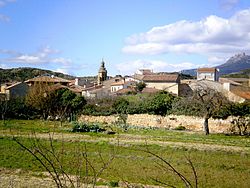Ábalos, La Rioja
| Ábalos | |
|---|---|
| Municipality | |

Ábalos
|
|
 Location in La Rioja |
|
| Coordinates: 42°34′18″N 2°42′37″W / 42.57167°N 2.71028°WCoordinates: 42°34′18″N 2°42′37″W / 42.57167°N 2.71028°W | |
| Country | Spain |
| Autonomous community |
La Rioja |
| Province | La Rioja |
| Government | |
| • Alcalde | Juan Rufino Blanco Sáez (People's Party) |
| Area | |
| • Total | 18.1 km2 (7.0 sq mi) |
| Population (2010) | |
| • Total | 369 |
| • Density | 20/km2 (53/sq mi) |
Ábalos (Spanish pronunciation: [ˈaβalos]) is a municipality in the autonomous region of La Rioja, Spain. Located in Rioja Alta, on the left bank of the river Ebro, near Haro. It is bounded on the north by the Toloño mountains and harbor de Herrera, to the south by San Asensio and Baños de Ebro, on the east by Samaniego and Villabuena de Álava and to the west by San Vicente de la Sonsierra.
In the Albeldense Chronicle the famous expedition conducted by Alfonso I, king of Asturias along the banks of the Ebro in 740 is mentioned. At that time, Ábalos was a part, as most of the mainland, of the Muslim kingdom of Córdoba. This account refers to the destroyed towns: Mirandam (now Miranda de Ebro), Revendecam, Carbonariam, Abeicam (Ábalos, from where he crossed the Ebro), Brunes (could be Briones but this is uncertain), Cinissariam (now Cenicero) and Alesanco. Control of the area then returned to Muslim hands until its final conquest in the late ninth and early tenth century.
In the eleventh and twelfth centuries the village is mentioned several times in the documents of the San Millán Monastery. Among them, as recorded by the Bishop Sandoval, the donation of the church of San Felix to the Monastery of San Millán, made by Gonzalo Núñez de Lara and his wife Goto Núñez in 1084.
In the fifteenth century it is known that Ábalos was village of San Vicente de la Sonsierra, whose lordship boasted different personages: Pedro Velasco, Pedro Girón, Juliana Aragón, Bernardino Velasco, etc. always due to numerous setbacks such as donations of gratitude, direct sales or inheritance.
...
Wikipedia
